Ah, a tournament for the ages! No, not the NCAA’s (though they have been
pretty terrific), I’m talking about the REAL event, the American Crossword
Puzzle Tournament (the “ACPT,” to those in the know), the 38th
annual, no less, which returned home to the Stamford Marriott this past
weekend. It had every element that
characterizes this amazing event – intense competition, for sure, but also healthy
doses of friendship, kindness, love, humility and humor – and then some, to put
it mildly.
The puzzle tournament is the invention of New York Times
puzzle editor Will Shortz, and he kicked off the proceedings on Friday night
with the tale of the ACPT’s origins.
This was appropriate, because the tournament was returning to the Stamford
Marriott after a seven-year absence, pushed out in 2008 by a jump in attendance
that could not be absorbed by the relatively cozy ballroom. The attendance bump was a direct result of
the release of “Wordplay,” a spectacular documentary that chronicled the 2005
tournament, the major participants, some celebrity solvers and the mystical
Shortz, as self-effacing and modest a hero as is possible, to his eternal
credit and our delight.
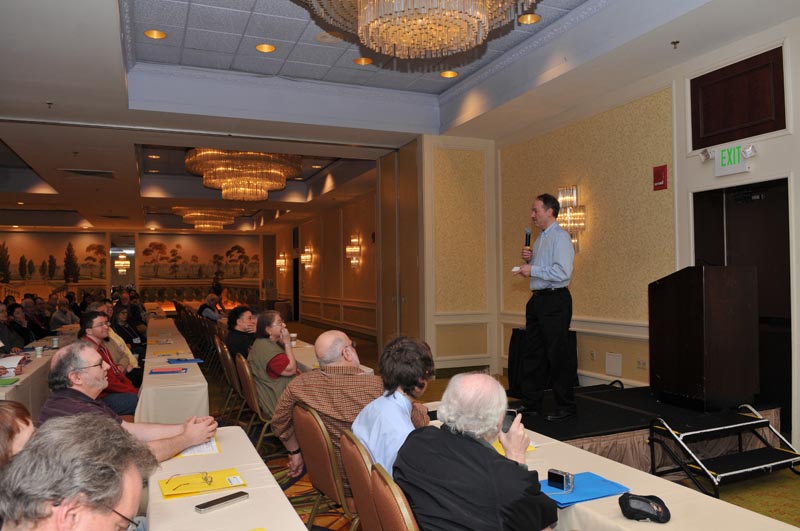 |
| Will Shortz on how it all began |
Shortz was a mere 25 years old when he was approached in
1977 by the marketing director of the then brand-new Stamford Marriott, Norton
Rhodes, who was looking for a winter weekend hook for the new hotel. Rhodes had approached Eugene Maleska,
Shortz’s predecessor at the Times, with the idea of a crossword puzzle tournament. Maleska turned him down but introduced him to
a friend in Stamford, who in turn knew Shortz.
On such a random spin of the wheel was history made.
That first contest in 1978 had 149 entrants and was won by
one Nancy Schuster, who, happily, was in attendance as well this past
weekend. So was Mimi Raphael, the second
winner in 1979, who would celebrate her 89th birthday on the Sunday
of the tournament.
Many former champions also competed this weekend, and
competed well. Crossword contestants
appear to hold their high standing well after the biological clock has slowed down
many an athlete. John Delfin, a
seven-time champ, sat right next to us, and Doug Hoylman, a six-time champ, was
in the room (and would claim top prize among 70-year olds). So was Ellen Ripstein, the champ in 2001, as
it happens, the first female champ since Mimi, and, alas, the last one as
well. And a sentimental favorite, Al
Sanders, who famously lost in 2005 by leaving a blank in the championship game,
denying him, a many time finalist, a shot at the crown (note that Al still
finishes in the Top 10 routinely), all while the “Wordplay” cameras were
rolling. Al is clearly a crowd favorite,
and the good grace with which he accepted his fate back then cemented his
status as the archetypal Good Guy.
But the tournament itself – the competition – really belongs
to two young men, Dan Feyer, age 37, and Tyler Hinman, age 30, who have won the
last ten tournaments between them, in an odd kind of succession. Tyler won in 2005 – yes, he beat Al Sanders
in that historic “Wordplay” event, at age 20, for goodness sake – and continued
to do so until 2009, when he was beaten by Feyer, who has held on since. The two are perfect counterpoints, Hinman,
red-haired, even younger looking than his age, emotive, with body language as
he competes that calls to mind the best of Carlton Fisk, versus Feyer, cool,
methodical, seemingly invincible. Think
Apple versus IBM, Mickelson versus Woods, Nadal versus Federer, Butch Cassidy
versus Joe Lefors…you get the idea.
The weekend unfolds in its routinized manner. The Friday night kick-off is an entertaining
warm up. After Shortz reviewed the
history of the tournament, young David Steinberg, aged 18, gave a talk on his
ongoing project that explores, analytically, the “Pre-Shortzian Era” of the New
York Times puzzles. This time Steinberg reported
on his efforts to identify the hundreds of anonymous constructors of puzzles of
that era (in those days, unlike today, the constructors of the Monday to
Saturday puzzles toiled anonymously). His
process was statistical in nature, using computer programs to divine the unique
patterns of constructors. Quite an
effort. He was followed by several
puzzles that were to be solved on IPads, that featured multi-media clues, to be
done in teams. Meet the future? The pencil and paper set surely hopes not,
and there were enough glitches in the software to give hope that the day this
becomes the norm is well off.
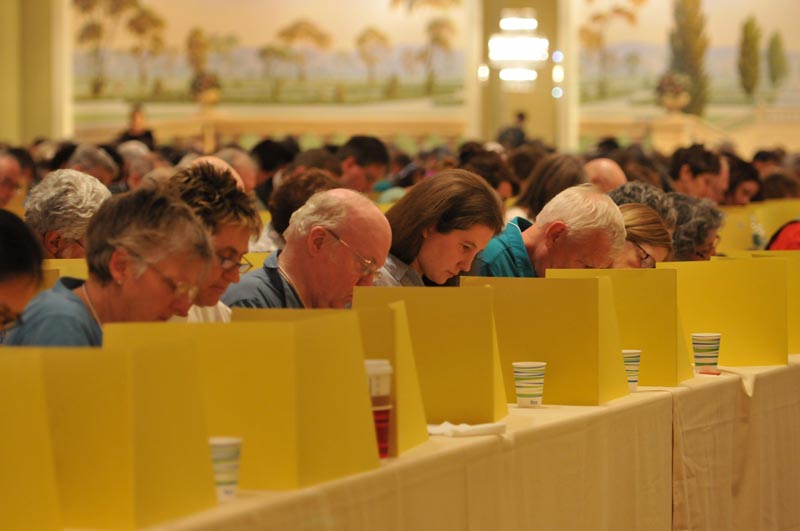 |
| The games begin |
The tournament began in earnest on Saturday. Six puzzles to be solved, from 11 AM to
roughly 5 PM, of varying length and difficulty.
An inadvertent guest coming across the ballroom might assume that some
grown-up version of the SATs was underway.
Near total silence fills the air as the contestants’ pencils scratched
(and if not pencils, then heads, in puzzlement) on grids against an ever
downward counting clock. Points
are awarded for both accuracy and speed, and the tension between the two is
often unbearable.
My wife, Wendy, our daughter, Kristy and I have been
competing as participants for four years now.
We attended two tournaments in the post-“Wordplay” years simply to
watch. We did not think we were good
enough to compete. But the tournament is
an “open” one, and if you are willing to fork over the entrance fee, you are
in. This year there were 560 or so
players, a level that allowed the tournament to return to the smaller Stamford
Marriott after the post-“Wordplay” boost forced the move to a larger Marriott
in Brooklyn. Thus, while we were
attending our sixth tournament in one capacity or another, this was our first
time in the hallowed Stamford setting.
Wendy and I typically finish ranked in the 500’s, a
testament to our rather modest skill level.
We are probably among the better solvers in our hometown, but in this
setting we are clearly bottom dwellers. My
goal is to crack the Top 500, which Wendy has already managed once. I have progressed from 542nd, to
518th, to a heartbreaking 503rd last year. Kristy, however, is quite good, and has
steadily risen from our level, (where she started) up to the mid-300’s. She even graduated from the lowest skill level
(where we reside), Division E, up to the next level, Division D. We are all a long way from the elite,
Division A, of course, but it is nice to see progress!
The Saturday puzzles have their own personalities, reflecting
the constructors, who, as David Steinberg assessed analytically, have unique
and discernible styles. Perhaps even
more defining, however, is the order of the puzzles. Puzzles 1, 4 and 6 are usually “easy” by the
standards of the collective whole, while puzzles 2 and 3 are harder. And then there is Puzzle 5, which is simply
agonizing. Those of us in the nether
region of the tournament rankings are tormented by Puzzle 5, and often find
ourselves staring at a largely blank piece of paper well into the 30 minutes
allotted to complete it.
 |
| Matt Ginsberg and "Dr. Fill" |
There are two noises that penetrate the silence during
puzzle completion. The first is the
printer attached to “Dr. Fill,” a computer program devised by computer
scientist Matt Ginsburg that is the crossword equivalent of “Watson,” the
famous IBM computer than handily whipped Ken Jennings, the legendary Jeopardy
champ a few years ago. While Dr. Fill is
not yet in Watson’s class – it finished 63rd last year, unofficially
– it does solve puzzles disconcertingly fast, if not always completely
accurately, and the rather loud printer that spits out his result almost always
punctuates the silence within one minute of the start.
The other noise is that off the better players leaving when
they are done, some just minutes after Dr. Phil’s printing, and the occasion of
their departure is marked by the clattering of the closing doors in exiting the
ballroom, a rather loud noise that is intimidating when the first few players
leave, and utterly devastating when exits begin in earnest as the mode of skill
level is found – with the rather clear reminder that you are far from that
mode, and in the wrong direction.
One of the many pleasures of the tournament is the bond one
forms with your immediate puzzle “neighbors,” those sitting next to you, in
front and behind as you solve. A yellow
cardboard divider nominally separates you from your neighbors, but after all
that silent tension in completing the puzzle there is a huge pent-up desire to
converse between puzzles. We always have
fun with our neighbors – almost certainly complete strangers – and this year we
were delighted to have a particularly fun crew.
Many thanks to Nicolette, Martha, Heidi, Paul and Susan!
After the six puzzles, the competition is suspended for the
night. On Sunday morning there is a seventh
puzzle, a juicy 45-minute one, followed by three sets of finals, one each (and
in turn) for Divisions C, B and A. But
first, the Saturday night festivities.
These vary from year to year, but this year was largely devoted to the
10th anniversary of “Wordplay.”
There was a kickoff of the world premiere of a short film on palindromes
– clearly we were the right crowd for the debut, and the film was greeted
enthusiastically.
The ‘Wordplay” director, Patrick Creadon, and his wife and producer
Christine O’Malley, took the stage, with a wonderful talk about the making of
the film, interspersed with scenes long memorized and fondly recalled by the
audience. Vic Fleming, a judge from
Arkansas who had talked former President Clinton, a crossword buff, into
appearing in the movie, took out his guitar and led the audience in a rendition
of his song, “If You Don’t Come Across, I’m Gonna Be Down.” If there is a crossworders’ national anthem,
that is it.
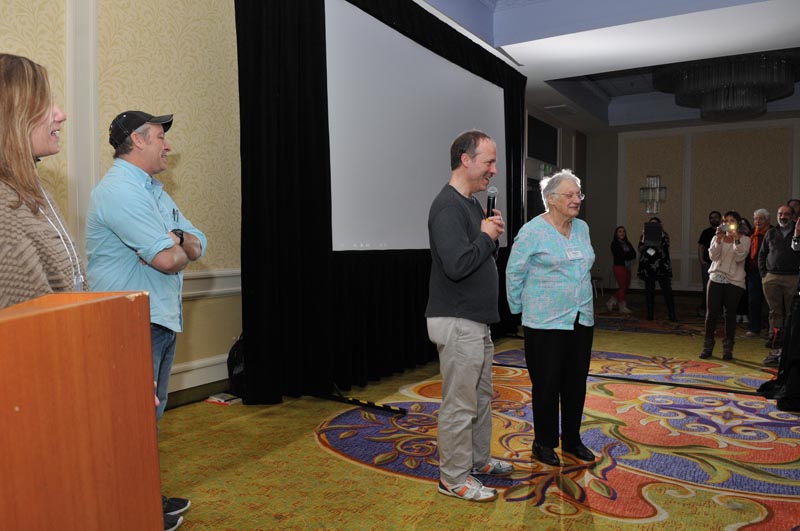 |
| Christine O'Malley, Patrick Creadon, Will Shortz and Mimi Raphael |
That we were back at the Stamford Marriott, the setting of
much of the film, added to the emotional punch of the evening. But all that was just the prelude. The talk ended with a scene from the movie
featuring Mimi Raphael, the woman who had, you will recall, won the second
tournament back in 1979 and would be celebrating her 89th birthday
the next day. In the clip, Mimi recalls
how her husband had died, years before, just after a tournament had ended, from
a heart attack he suffered in the lobby of that very Marriott, as they were
leaving. And she went on to say that it was
difficult to come back but her husband would have wanted her to do so because
it was such an important part of her life, and that she never went out the
lobby entrance again. When the clip ended,
we were all teary-eyed, and then we sang a heartfelt “Happy Birthday” to
Mimi as she stood up before us.
All this before an unforgettable Sunday! We attacked Puzzle 7 first thing in the
morning, one of the easier puzzles that I finished just under the closing bell
(as it happened, with three letters wrong).
At this point, I was in 462nd place, feeling some mix of confidence
and trepidation about the chances of meeting my goal of finishing in the Top 500. (Those
wrong answers can really hurt; among other penalties, you are denied a
150-point bonus for a perfect puzzle.)
And then came one of the more charming aspects of the
weekend, the Talent Show (a.k.a. “Crossworders Got Talent.”) This is essentially a light filler to kill
time while the final scores are tallied to determine the A, B and C
finalists. For an hour, about 8-10 acts
take the stage, amateur musicians, poets, stand-up comedians, even jugglers at
times, who often tailor their acts to crossword themes.
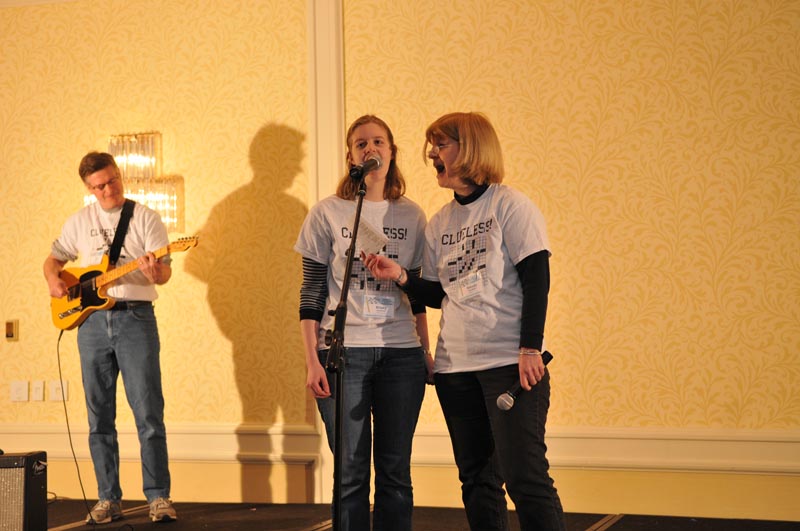 |
| "Clueless" |
We are performers in this event. We put together a little band that we call
“Clueless” (complete with t-shirts), which speaks to our crosswording ability
as well as our musical talent. I play a
little guitar, Kristy sings and Wendy plays the piano (although this year, the
Marriott had no piano and Wendy heroically jumped into the role of back-up
singer). We do song parodies. Last year we sang about what a “Wonderful
World” it would be if we (well, I) could crack the Top 500, and this year’s
effort was themed around the notorious Puzzle 5, with appropriately
desperate lyrics set to the tune of the 1980’s mega-hit “Don’t Stop Believing.”
We were in good company.
The legendary puzzle constructor Merl Reagle opened with some word games
cum stand-up. Vic Fleming performed
lovely puzzle-themed duets with Matt Ginsberg’s daughter. Other acts, by contestants whose names I
missed, included a love lament and a song dedicated to the constructors of the
New York Times’ Saturday puzzles (the hardest of all). Mimi’s sister told a story, and the blues
guitarist Tommy Lee Cook ended with a medley (he’s a pro, I was proud that he
was using my amp!) and then led the group in another rousing (and
blues-infested) version of “Happy Birthday to Mimi” to cap it off.
The Talent Show was followed by the awards ceremony, which
honored top finishers by age, geographic region, skill division and the
like. We looked on in envy as Will
called up the honorees one by one, who received their trophy and a free puzzle
book of their choice.
And then came the finals.
The format is rather surreal for the finalists. Three large easels holding blank puzzle forms
are set up facing the audience. Each
player dons a headset to block out noise (not with silence, but with taped U.N.
deliberations, of all things; Will assured us this was soothing, not
distracting, hard as that is to believe).
The three finalists start the puzzle on a staggered basis, in the order of
how many points they amassed in the competition….the more points one is ahead,
the more precious seconds head start one receives. Remember this particular rule as you read on.
The Division C competition featured the first of perhaps
many wins by young David Steinberg (of “Pre-Shortzian” fame). Steinberg finished second in terms of time,
but Alex Egervary, who finished first in speed, had one wrong, whereas
Steinberg was perfect.
For the Division A and B finals, the same puzzle is used as
in Division C, except the clues are different and that much harder. The other difference was the introduction of
“announcers” into the proceedings, in the persons of much-honored music
composer and orchestrator Greg Pliska and stand up comic and NPR host Ophira
Eisenberg. They are completely suited to
the task and are generally hysterical. Greg
kicks off the proceedings echoing the late Cub Ernie Banks…”it’s a beautiful
day for a crossword puzzle, let’s play two!”
Greg Pliska’s story was yet another bit of kismet injected into
the weekend. As it happens, he and his
wife, Jessica, first met at this very tournament in, yes, 2005 (the “Wordplay”
year); they were married within a year of meeting, and now have two delightful
children. Greg is one of the two
tournament regulars that I knew in a prior life…we both attended Williams
College and served together on an alumni committee years ago. As it happens, not at all surprisingly, we
both participated religiously in the Williams College Trivia Contest, an event
of even longer lineage than the ACPT.
The Williams contest will be celebrating its 50th anniversary
(and 100th contest, since it is biannual) in 2016. My teams have won four Trivia Contests over those
years, while Greg has played on three winners.
Andrew Feist took the Division B title, and with that, all
that was left was the main event. Given
the extraordinary karma that existed throughout the weekend, it ended the only
way it possibly could have. Dan Feyer
headed into the event on top, with enough of a lead to earn five extra seconds
over Tyler Hinman. Howard Barkin, an extraordinary player on his own, a three-time finalist, was not to be
discounted either, as he had tied Tyler in points and they would start at the same
time.
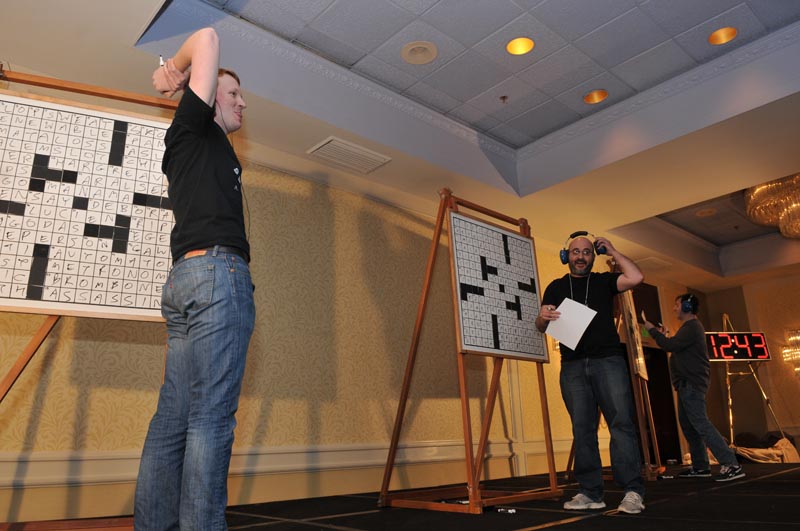 |
| Seconds after, Tyler and Dan |
If the Division B clues were very hard, the Division A
clues were, in Will’s own terms, “excruciating.” Byron Walden had constructed the puzzle and
it was worthy of the event. (Byron had,
of course, also constructed the finals puzzle used in 2005.) Dan seemed to grab command early. Tyler, arms flailing, had trouble making any
dent in the board at the outset. But
suddenly Tyler found his rhythm and seemed to edge ahead as the puzzles neared
completion. From then on, with rising
excitement, the audience rumbled and then roared until only a few empty boxes
remained. And then Dan raised his hand,
followed nearly instantly by Tyler, and it was over. Dan needed every one of those five bonus
seconds he had earned over the course of the two days to prevail, winning by,
at most, half a second. The crowd was in
bedlam (while poor Howard, doubtless cognizant that something extraordinary had
just happened, if only through the vibrations in his feet, plowed on), and
Tyler theatrically crumbled to the ground, lying flat in despair.
Tyler did a wonderful job alternating between expressing
his sheer wonder at what had just transpired with his genuine disappointment at
falling just shy. While he has been a
finalist, and lost to Dan before, it was never this close. But he had actually completed the puzzle in a
faster time than Dan, and surely that augers well for next year.
Dan, now with six titles, has said he would quit at eight
if he reached it, a level that would push him past John Delfin and establish
him as the all-time leader. I wonder if
he has considered that if he indeed managed to win twice more, and then
retired, that, given his age, Tyler would have a very good chance of reclaiming
the top mark with four quick wins in his absence. Would Dan return then, a la Muhammad Ali, to
challenge his usurper?
We can only wait to see how it all unfolds. Or to see if Howard Barkin steps up, or Joon
Pahk or Kiran Kedlaya break into the finals, or Anne Erdmann or Al Sanders returns
to the finals and wins.
As for us….well, Kristy rocketed all the way to 306th,
yet another major leap up the ladder.
Wendy came in at 515th, unable to do one perfect puzzle, and she is
already strategizing on how to improve.
As for me, I finally did it…I cracked the Top 500, and finished in 468th. And, indeed, for that, and for that amazing
weekend, what a wonderful world it is.
Great puzzles are the work of great constructors, masters
at their craft. But a weekend like this
depends on much more. Will Shortz has
built an amazing thing in 38 years, an event that is incredibly human and
warm-spirited in nature, where life and love are celebrated in ways that exceed
the boundaries of acrosses and downs.
See you all next year!
(All photographs taken by Don Christensen, reprinted with thanks!)




